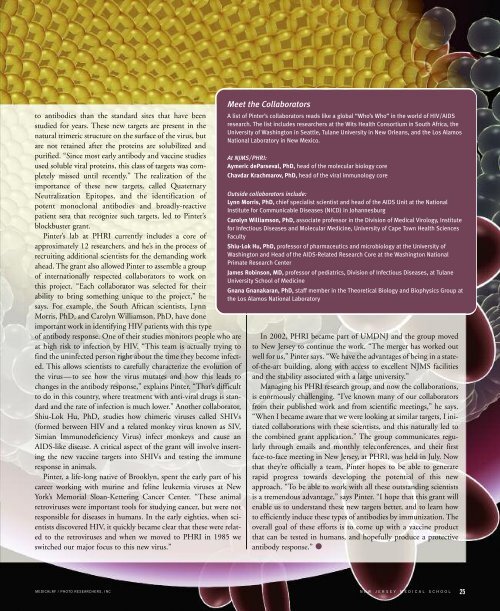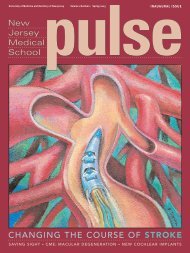PINTER'S - New Jersey Medical School
PINTER'S - New Jersey Medical School
PINTER'S - New Jersey Medical School
You also want an ePaper? Increase the reach of your titles
YUMPU automatically turns print PDFs into web optimized ePapers that Google loves.
to antibodies than the standard sites that have been<br />
studied for years. These new targets are present in the<br />
natural trimeric structure on the surface of the virus, but<br />
are not retained after the proteins are solubilized and<br />
purified. “Since most early antibody and vaccine studies<br />
used soluble viral proteins, this class of targets was completely<br />
missed until recently.” The realization of the<br />
importance of these new targets, called Quaternary<br />
Neutralization Epitopes, and the identification of<br />
potent monoclonal antibodies and broadly-reactive<br />
patient sera that recognize such targets, led to Pinter’s<br />
blockbuster grant.<br />
Pinter’s lab at PHRI currently includes a core of<br />
approximately 12 researchers, and he’s in the process of<br />
recruiting additional scientists for the demanding work<br />
ahead. The grant also allowed Pinter to assemble a group<br />
of internationally respected collaborators to work on<br />
this project. “Each collaborator was selected for their<br />
ability to bring something unique to the project,” he<br />
says. For example, the South African scientists, Lynn<br />
Morris, PhD, and Carolyn Williamson, PhD, have done<br />
important work in identifying HIV patients with this type<br />
of antibody response. One of their studies monitors people who are<br />
at high risk to infection by HIV. “This team is actually trying to<br />
find the uninfected person right about the time they become infected.<br />
This allows scientists to carefully characterize the evolution of<br />
the virus—to see how the virus mutates and how this leads to<br />
changes in the antibody response,” explains Pinter. “That’s difficult<br />
to do in this country, where treatment with anti-viral drugs is standard<br />
and the rate of infection is much lower.” Another collaborator,<br />
Shiu-Lok Hu, PhD, studies how chimeric viruses called SHIVs<br />
(formed between HIV and a related monkey virus known as SIV,<br />
Simian Immunodeficiency Virus) infect monkeys and cause an<br />
AIDS-like disease. A critical aspect of the grant will involve inserting<br />
the new vaccine targets into SHIVs and testing the immune<br />
response in animals.<br />
Pinter, a life-long native of Brooklyn, spent the early part of his<br />
career working with murine and feline leukemia viruses at <strong>New</strong><br />
York’s Memorial Sloan-Kettering Cancer Center. “These animal<br />
retroviruses were important tools for studying cancer, but were not<br />
responsible for diseases in humans. In the early eighties, when scientists<br />
discovered HIV, it quickly became clear that these were related<br />
to the retroviruses and when we moved to PHRI in 1985 we<br />
switched our major focus to this new virus.”<br />
Meet the Collaborators<br />
A list of Pinter’s collaborators reads like a global “Who’s Who” in the world of HIV/AIDS<br />
research. The list includes researchers at the Wits Health Consortium in South Africa, the<br />
University of Washington in Seattle, Tulane University in <strong>New</strong> Orleans, and the Los Alamos<br />
National Laboratory in <strong>New</strong> Mexico.<br />
At NJMS/PHRI:<br />
Aymeric deParseval, PhD, head of the molecular biology core<br />
Chavdar Krachmarov, PhD, head of the viral immunology core<br />
Outside collaborators include:<br />
Lynn Morris, PhD, chief specialist scientist and head of the AIDS Unit at the National<br />
Institute for Communicable Diseases (NICD) in Johannesburg<br />
Carolyn Williamson, PhD, associate professor in the Division of <strong>Medical</strong> Virology, Institute<br />
for Infectious Diseases and Molecular Medicine, University of Cape Town Health Sciences<br />
Faculty<br />
Shiu-Lok Hu, PhD, professor of pharmaceutics and microbiology at the University of<br />
Washington and Head of the AIDS-Related Research Core at the Washington National<br />
Primate Research Center<br />
James Robinson, MD, professor of pediatrics, Division of Infectious Diseases, at Tulane<br />
University <strong>School</strong> of Medicine<br />
Gnana Gnanakaran, PhD, staff member in the Theoretical Biology and Biophysics Group at<br />
the Los Alamos National Laboratory<br />
In 2002, PHRI became part of UMDNJ and the group moved<br />
to <strong>New</strong> <strong>Jersey</strong> to continue the work. “The merger has worked out<br />
well for us,” Pinter says. “We have the advantages of being in a stateof-the-art<br />
building, along with access to excellent NJMS facilities<br />
and the stability associated with a large university.”<br />
Managing his PHRI research group, and now the collaborations,<br />
is enormously challenging. “I’ve known many of our collaborators<br />
from their published work and from scientific meetings,” he says.<br />
“When I became aware that we were looking at similar targets, I initiated<br />
collaborations with these scientists, and this naturally led to<br />
the combined grant application.” The group communicates regularly<br />
through emails and monthly teleconferences, and their first<br />
face-to-face meeting in <strong>New</strong> <strong>Jersey</strong>, at PHRI, was held in July. Now<br />
that they’re officially a team, Pinter hopes to be able to generate<br />
rapid progress towards developing the potential of this new<br />
approach. “To be able to work with all these outstanding scientists<br />
is a tremendous advantage,” says Pinter. “I hope that this grant will<br />
enable us to understand these new targets better, and to learn how<br />
to efficiently induce these types of antibodies by immunization. The<br />
overall goal of these efforts is to come up with a vaccine product<br />
that can be tested in humans, and hopefully produce a protective<br />
antibody response.”<br />
MEDICALRF / PHOTO RESEARCHERS, INC N E W J E R S E Y M E D I C A L S C H O O L 25






